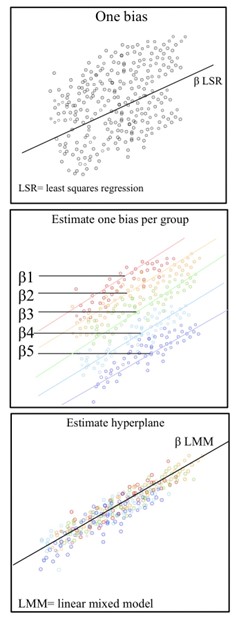Mixed model
Mixed model is a statistical model that contains both fixed effects and random effects. These models are particularly useful in situations where observations are correlated, which is a common occurrence in many areas of research including biostatistics, social sciences, and agriculture. Mixed models allow for the analysis of data that would otherwise violate the assumptions of traditional models such as linear regression, making them a versatile tool in statistical analysis.
Overview[edit | edit source]
A mixed model extends the general linear model (GLM) by incorporating random effects in addition to the fixed effects of the GLM. Fixed effects are constants and represent the average relationship between the dependent and independent variables across all units of analysis. In contrast, random effects vary across units and account for variations not explained by the fixed effects, allowing for the analysis of grouped or hierarchical data structures.
Components of Mixed Models[edit | edit source]
Mixed models consist of several key components:
- Fixed Effects: These are the estimated parameters associated with the entire population or certain repeatable levels of experimental factors. They are akin to the coefficients in traditional regression models.
- Random Effects: These effects are associated with individual experimental units drawn at random from a population. Random effects account for the variability within groups or subjects in the data.
- Covariance Structure: This defines how the random effects and error terms are correlated within the model. Choosing an appropriate covariance structure is crucial for accurate model estimation.
- Dependent Variable: The outcome or response variable that the model aims to predict or explain.
- Independent Variables: Also known as predictors, these variables are used to explain variations in the dependent variable. They can be fixed or vary across levels of another variable.
Applications[edit | edit source]
Mixed models are widely used across various fields of study:
- In biostatistics, they are used to analyze longitudinal data where measurements are taken on the same subjects over time.
- In agriculture, mixed models can analyze data from experiments with random effects such as random blocks or plots.
- In the social sciences, they are applied to multilevel or hierarchical data, such as students nested within schools.
Advantages[edit | edit source]
The primary advantage of mixed models is their flexibility in handling data with complex structures, including correlations within groups, hierarchies, and repeated measures. They provide unbiased, efficient estimates even when data are missing randomly, making them superior to traditional methods in many cases.
Challenges[edit | edit source]
One of the main challenges in using mixed models is determining the correct structure for the random effects and the covariance matrix. This often requires extensive knowledge of the data and the context of the study. Additionally, fitting mixed models can be computationally intensive, especially for large datasets or complex models.
Software[edit | edit source]
Several statistical software packages offer capabilities for fitting mixed models, including R (through packages like lme4 and nlme), SAS (PROC MIXED), and SPSS.
Conclusion[edit | edit source]
Mixed models are a powerful tool for analyzing data that exhibit complex patterns of variability. By accommodating both fixed and random effects, they allow researchers to explore and understand data in ways that traditional models cannot. However, their application requires careful consideration of the model structure and an understanding of the underlying assumptions.
Search WikiMD
Ad.Tired of being Overweight? Try W8MD's physician weight loss program.
Semaglutide (Ozempic / Wegovy and Tirzepatide (Mounjaro / Zepbound) available.
Advertise on WikiMD
|
WikiMD's Wellness Encyclopedia |
| Let Food Be Thy Medicine Medicine Thy Food - Hippocrates |
Translate this page: - East Asian
中文,
日本,
한국어,
South Asian
हिन्दी,
தமிழ்,
తెలుగు,
Urdu,
ಕನ್ನಡ,
Southeast Asian
Indonesian,
Vietnamese,
Thai,
မြန်မာဘာသာ,
বাংলা
European
español,
Deutsch,
français,
Greek,
português do Brasil,
polski,
română,
русский,
Nederlands,
norsk,
svenska,
suomi,
Italian
Middle Eastern & African
عربى,
Turkish,
Persian,
Hebrew,
Afrikaans,
isiZulu,
Kiswahili,
Other
Bulgarian,
Hungarian,
Czech,
Swedish,
മലയാളം,
मराठी,
ਪੰਜਾਬੀ,
ગુજરાતી,
Portuguese,
Ukrainian
Medical Disclaimer: WikiMD is not a substitute for professional medical advice. The information on WikiMD is provided as an information resource only, may be incorrect, outdated or misleading, and is not to be used or relied on for any diagnostic or treatment purposes. Please consult your health care provider before making any healthcare decisions or for guidance about a specific medical condition. WikiMD expressly disclaims responsibility, and shall have no liability, for any damages, loss, injury, or liability whatsoever suffered as a result of your reliance on the information contained in this site. By visiting this site you agree to the foregoing terms and conditions, which may from time to time be changed or supplemented by WikiMD. If you do not agree to the foregoing terms and conditions, you should not enter or use this site. See full disclaimer.
Credits:Most images are courtesy of Wikimedia commons, and templates, categories Wikipedia, licensed under CC BY SA or similar.
Contributors: Prab R. Tumpati, MD



